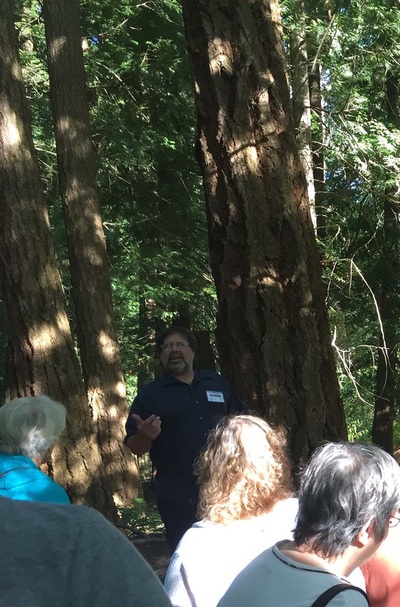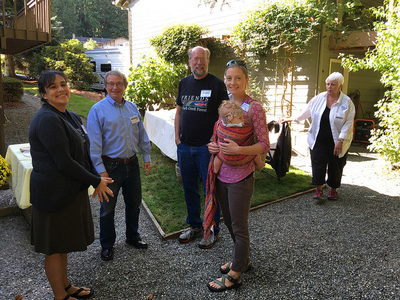|
We are excited to once again have students from the Soundview School visit monthly to help take care of North Creek Forest. This month, the entire 8th grade came out to explore the forest and help keep invasive blackberry and bindweed at bay. Education Committee member, Emily Sunblade took students on an un-nature hike to hone their observation skills and explore deeper into the forest. Thank you Soundview! We always appreciate your hard work and enthusiasm!
0 Comments
 By Cathy Ferbrache, FNCF Board Member On a gorgeous September afternoon over 60 people gathered in the backyard of Jeanie and Tom Robinson to celebrate what their support helped to accomplish in North Creek Forest and to learn more about the work ahead. There was time for socializing and enjoying homemade appetizers and Northwest wines before going on tours of the forest, led by Dr. Warren Gold and some of his UW Restoration Ecology Network students (UW-REN). Prior to the tours participants studied bark samples prepared by Carolyn Freese so that, once in the forest, they could ID western redcedar, Douglas-fir, maple, dogwood and alder. Armed with their knowledge of each tree’s particular bark, the first stop was a mature part of the Forest with lots of evergreen trees, shade, and little understory. Tourists divided into small groups and each group measured the circumference of two trees. Using an online scientific model called the National Tree Benefit Calculator, student leaders calculated the pounds of carbon captured by their trees (in one group a maple tree captured 585 lbs. and a slightly smaller Douglas-fir took in 347 lbs. of carbon per year). An average mid-size car emits 11,000 lbs. of carbon dioxide every year. It would take about 20 Big Leaf Maples or 31 Douglas-firs of this size to offset one average gas-powered car’s annual carbon emissions. Dr. Gold described this as an example of “ecological economics” which puts human values (often in dollar terms that people can relate to most easily) on the ecosystem services that trees provide. Among many things, trees stabilize slopes, retain water runoff, provide wildlife habitat, restore human connection with the earth, and sequester carbon. A second tour stop was an area where, from one to two years earlier, UW-REN students did extensive restoration. Here there was more light and heat and more understory growth of Nootka Rose, Salmonberry, and conifers just starting to take root and grow. Though the vegetation in the restored area captures only a fraction of carbon compared to the big trees in the more mature part of the forest, this careful restoration assures the future of the forest and the ecological services that it provides. After returning to the Robinson’s backyard, Dr. Gold debriefed participants and noted that, in the face of habitat and species extinctions, people gathering to support and learn more about this forest gives him hope for the future. Bothell’s Mayor Andy Rheaume spoke about the huge local interest from the community to preserve open spaces like North Creek Forest. His hope is that this consciousness about the value of trees will shape nature-friendly development as the local population soars.
We are happy to report that to date, the fundraiser has raised more than $10,500! Your generosity was met with over $9,500 in matching funds, for a grand total of more than $20,000! Additional contributions, of any amount, are still welcome, and we have $500 to go to max out the matching funds. Donations of $250 or more, or any Forest Keeper recurring contribution will be matched at its total annual amount (e.g. a contribution of just $10/month will receive a match of $120). Gifts must be made (or pledged) by the end of September. We only need a few more donations to meet our goal! Thank you for your generosity and your support of this important work in North Creek Forest.
Update: We are now just $124 short of our goal for matchable funds! Just one more recurring contribution of $11/month will exceed our goal and maximize the match! |
Categories
All
__Archives
March 2020
|









 RSS Feed
RSS Feed
